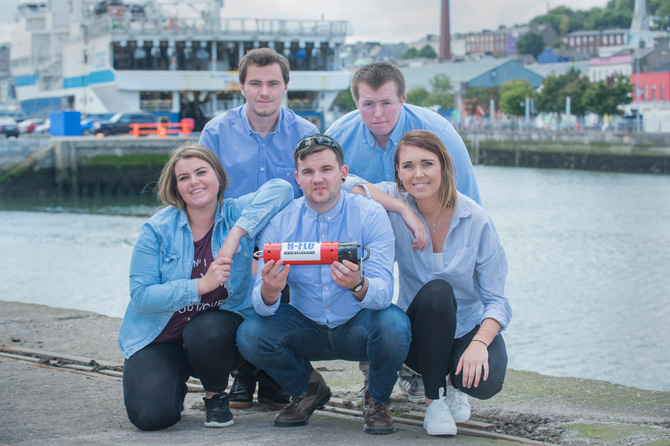CIT Students’ Marine Safety Invention Wins 2016 Irish James Dyson Award

Published on: Thursday, 08 September 2016
A new device designed to prevent workmen getting trapped under water and drowning has won the prestigious 2016 Irish leg of the James Dyson award.
A team of engineering students from Cork Institute of Technology were inspired to invent the HydroFLOcean following the high-profile deaths of two labourers in Limerick last year.
TJ O’Herlihy and Bryan Whelan drowned after their work platform collapsed whilst they were carrying out maintenance works on Thomond Bridge over the River Shannon in August 2015.
Platforms or maintenance cages are often used when working at heights and workers are typically secured to the work platform via a harness and lanyard. Although a rare occurrence, if the platform does collapse over a body of water, the individual faces the risk of becoming submerged whilst still connected to it. Underwater it is a lot more difficult to detach from the platform and, as in the case of the Limerick men, can result in fatality.
The HydroFLOcean (H-FLO) separates the user from the work platform when it is submerged in water. It is attached to the workman’s harness on one side and to the safety cable connecting to the maintenance platform on the other. It uses the same inflation device used in life jackets to activate a gas canister when submerged in water. The H-FLO is composed of two cylindrical metal shafts connected via a 10mm stainless steel pin. Upon submersion in water, the gas canister inside uses ten megapascals of pressure to force the pin out, causing the device to split in two. This separates the user from the sinking platform.
A team of eight students (7 engineering and one business) at Cork Institute of Technology developed the concept and built a working prototype.

Project manager Arran Coughlan (27) said the idea came to the group in a brainstorming session shortly after they started back at college last year. ‘The Limerick tragedy had only happened a couple of weeks before college started back, so it was pretty fresh in our minds. We were tasked with coming up with an innovative device, and it all took off from there’, Arran explains.
The other team members are Shane O' Driscoll, Gerard O' Connell, Kelly Lane, George O' Rourke, John Harrington, Jason Shorten and Kacey Mealy. They then built a working prototype, soldering and filing in the engineering workshop at CIT.
The device has been rigorously tested, and the team say it is totally unique. The future plans for the H-FLO involve the group finding new markets that the technology can be applied to. They believe that this technology could save lives in areas such as the automotive industry and in offshore oil rigging.
Arran says there is a definite a gap in the marine safety market: “We’re looking forward to exploring the possibilities and educating ourselves on the different opportunities for us to expand H-Flo.”
They have already won the CIT prize for innovation 2016, the prestigious Cruickshank Intellectual Property Attorneys award and now the prestigious 2016 Irish James Dyson Award.
The team will now proceed to the international stage of the competition and will compete against students from 22 different countries to win the overall James Dyson award and the grand prize of €35,000. Dyson engineers will announce the top 20 international finalists on the 29th September and the overall global winner will be selected by James Dyson and announced on the 27th October 2016.









